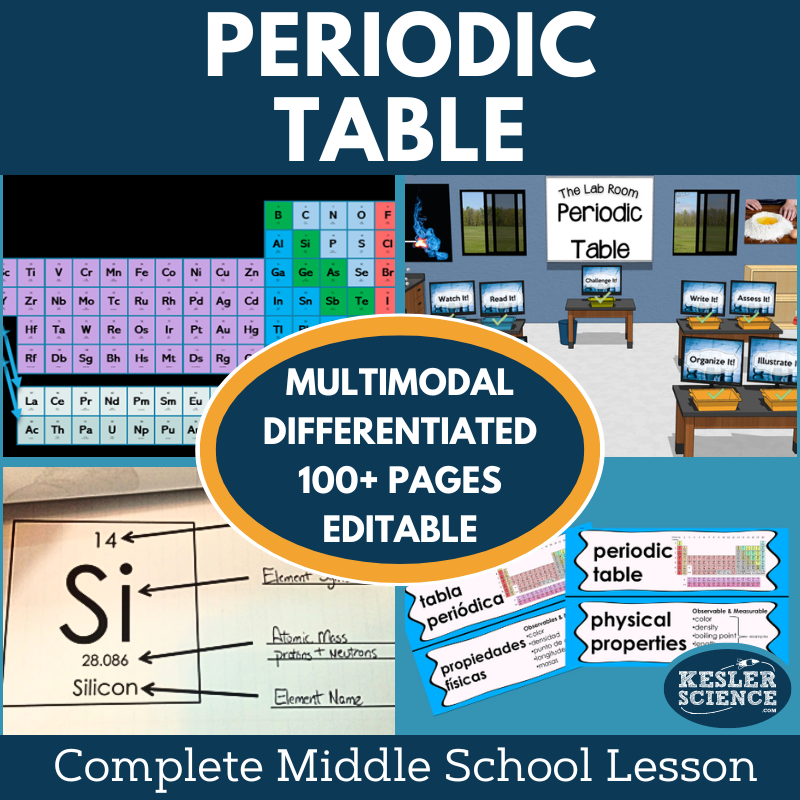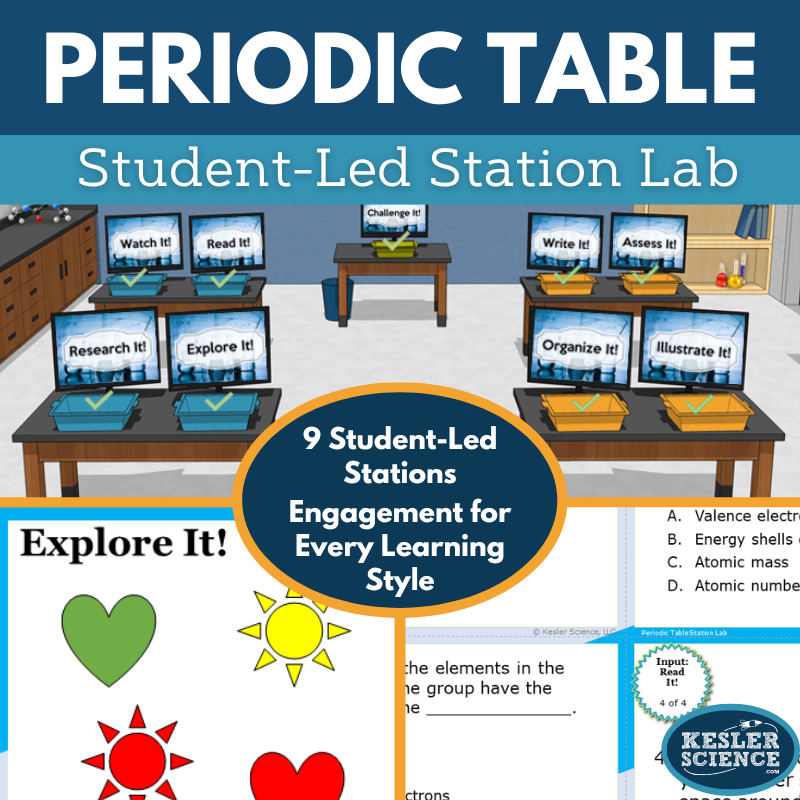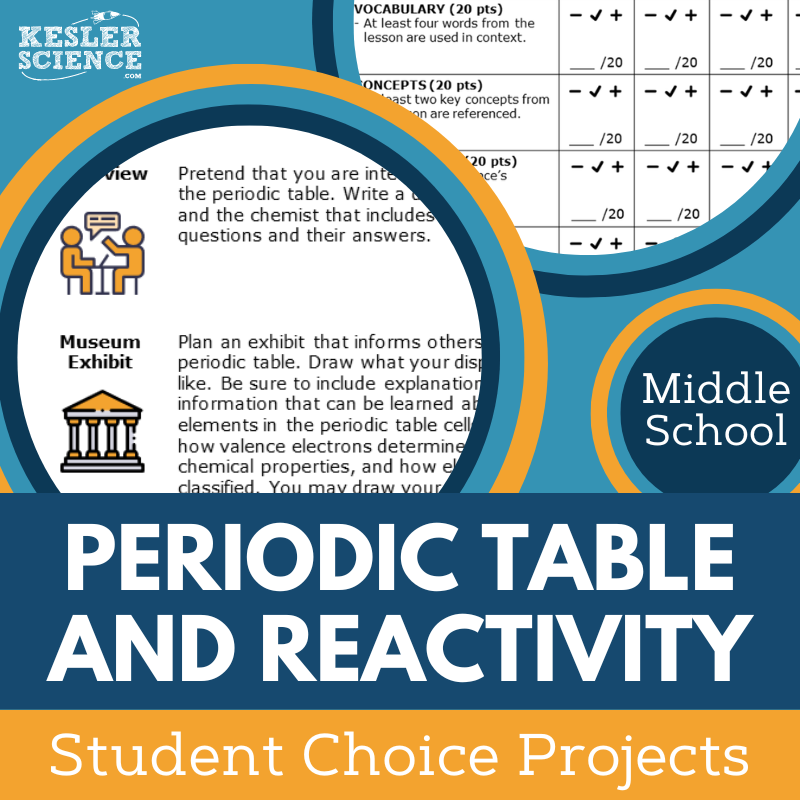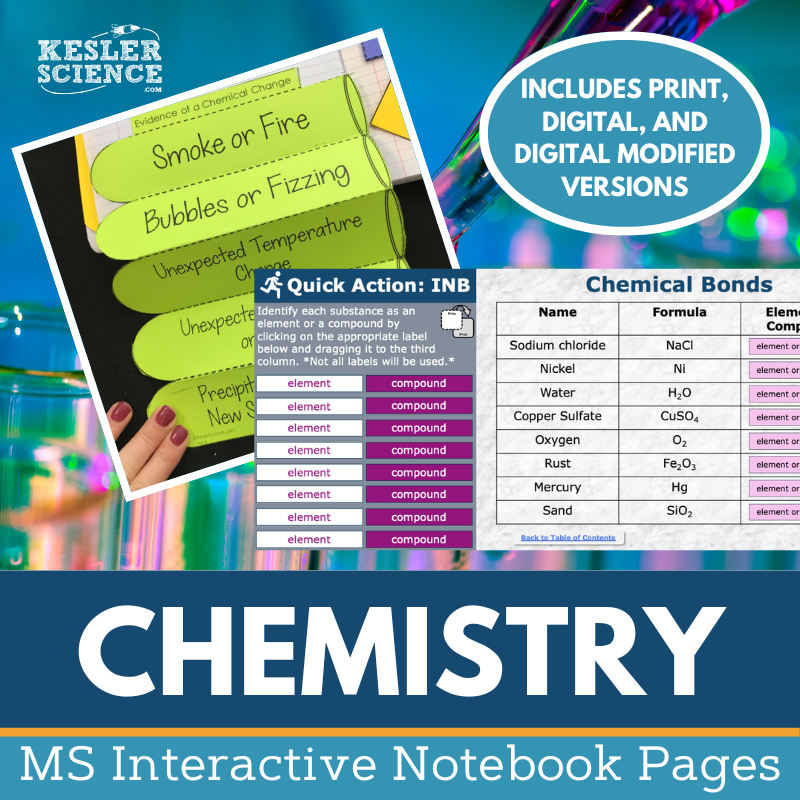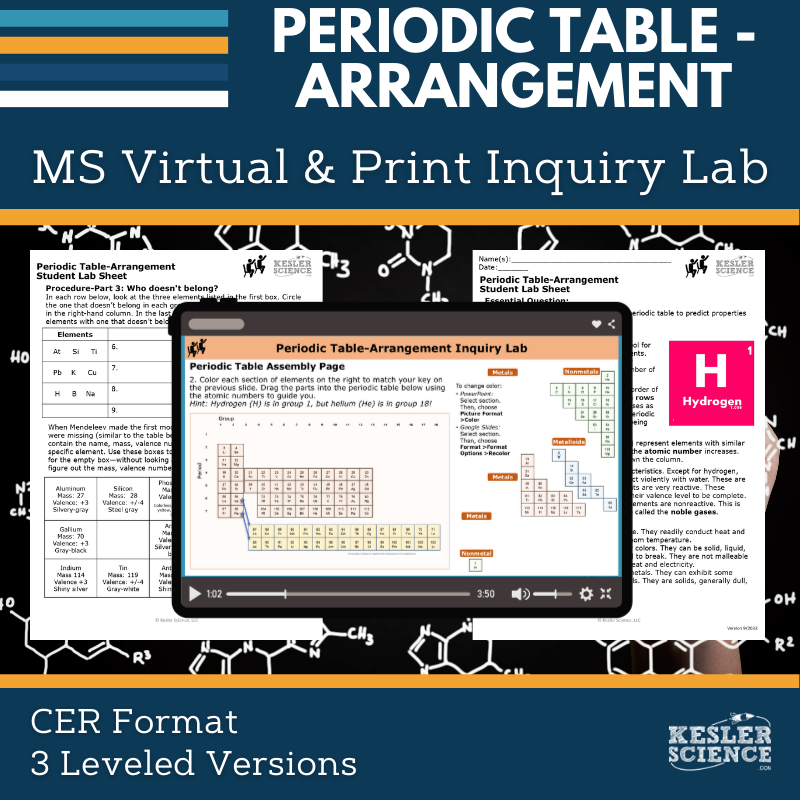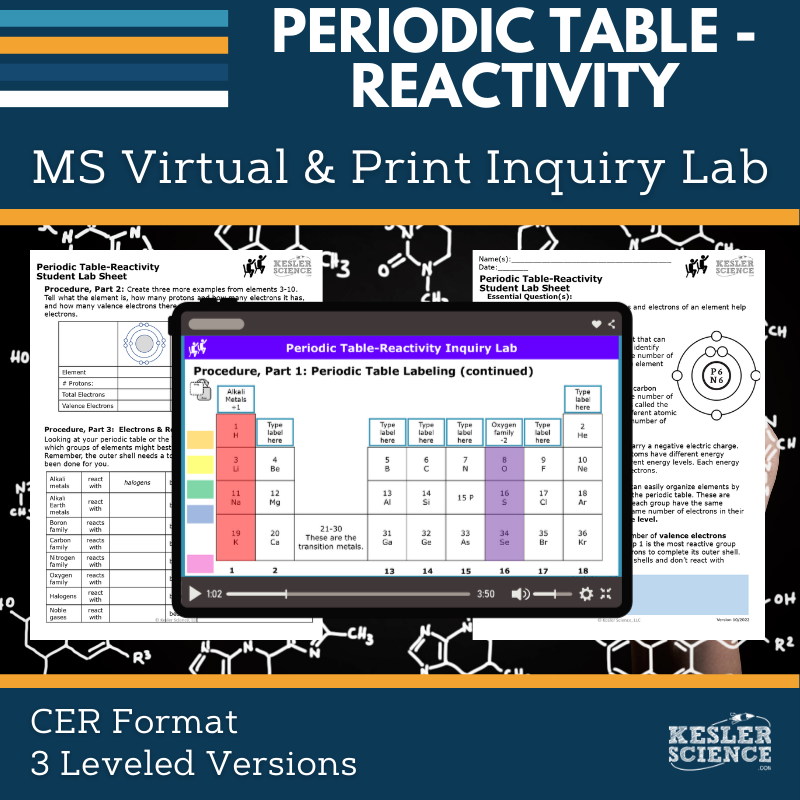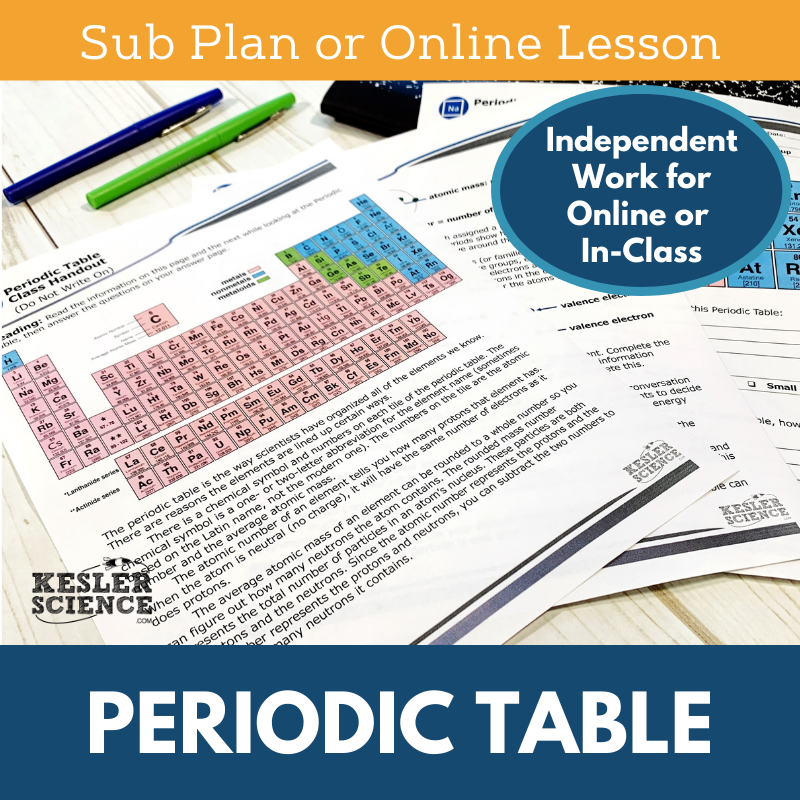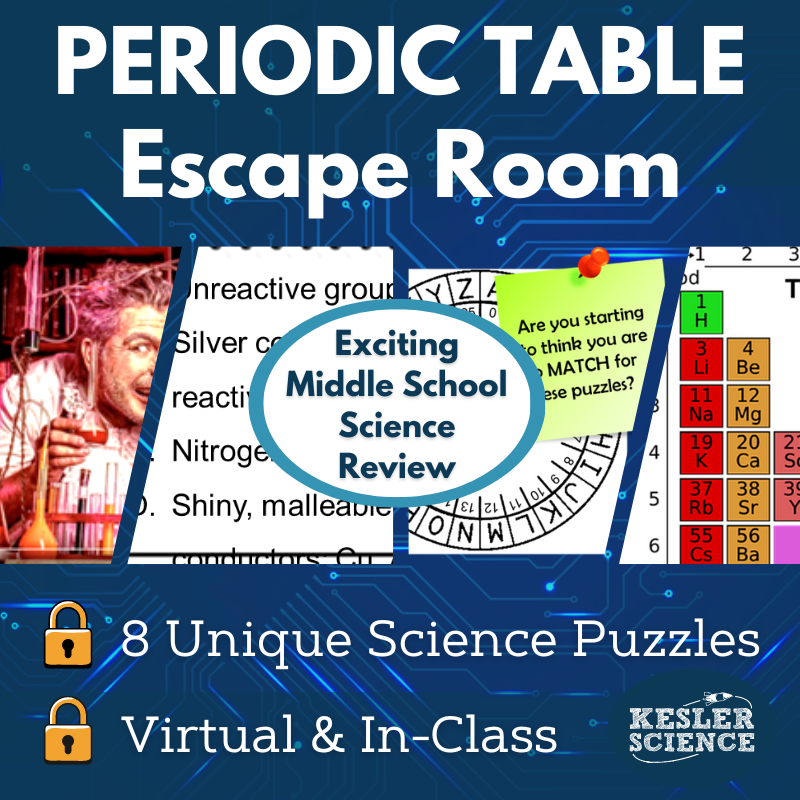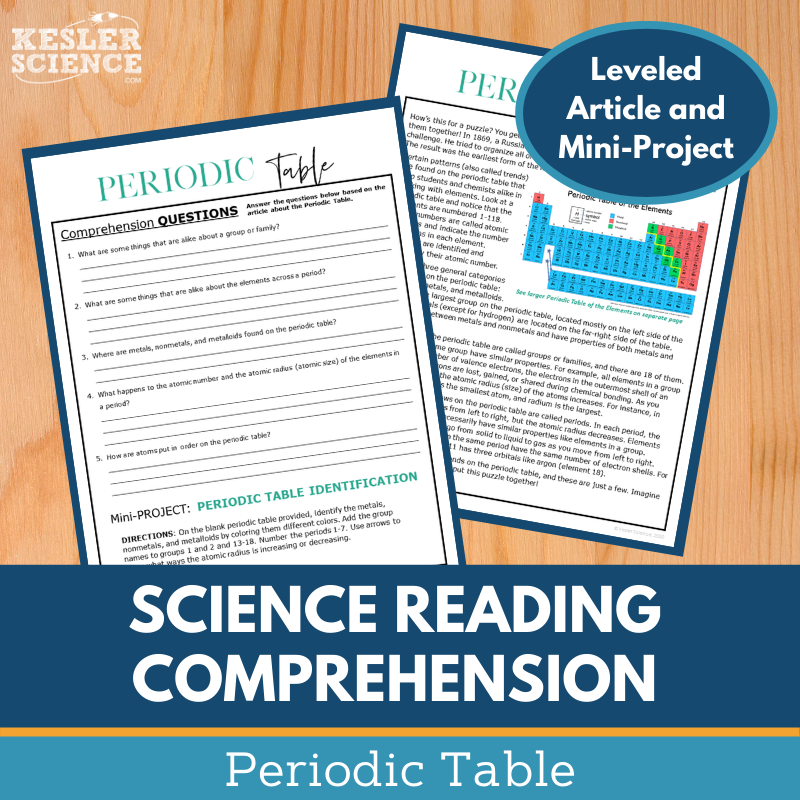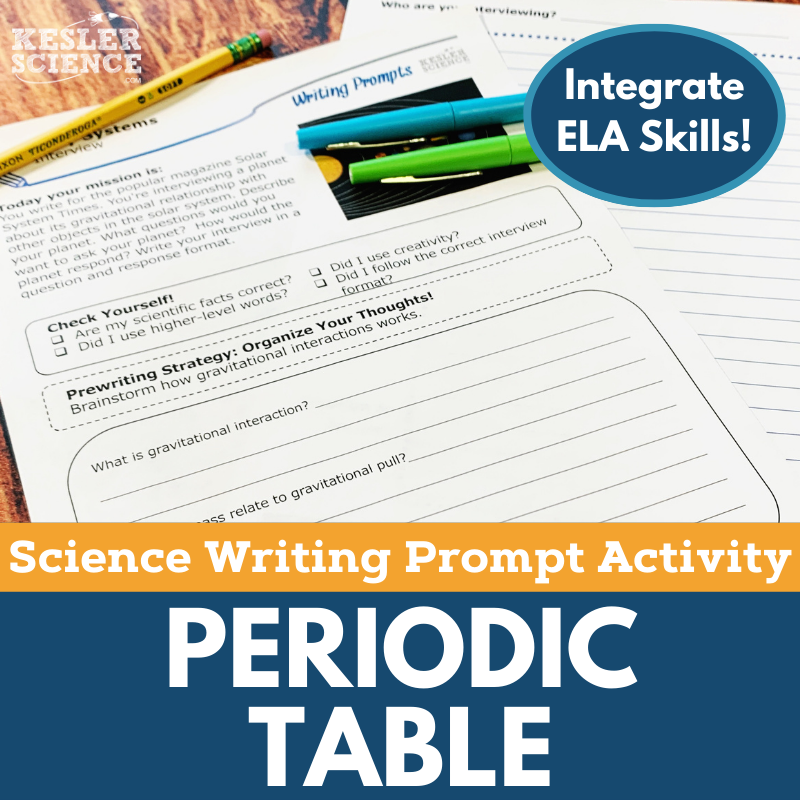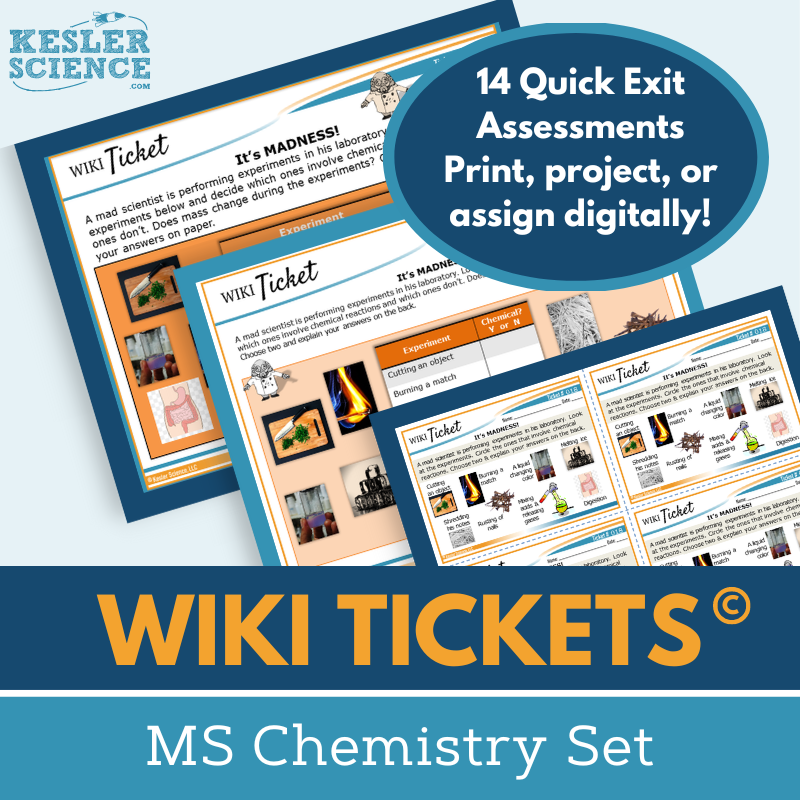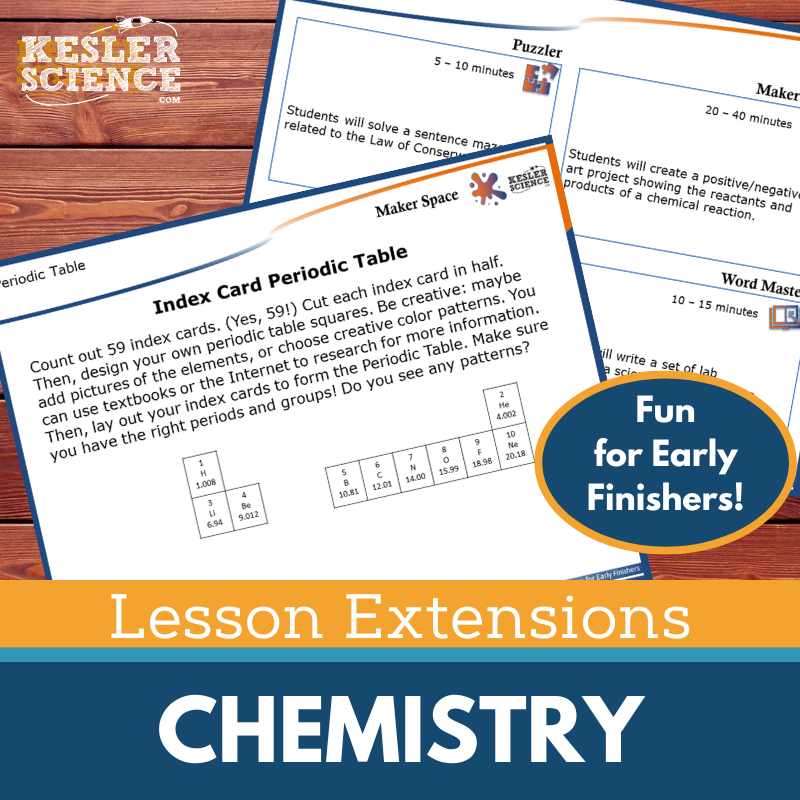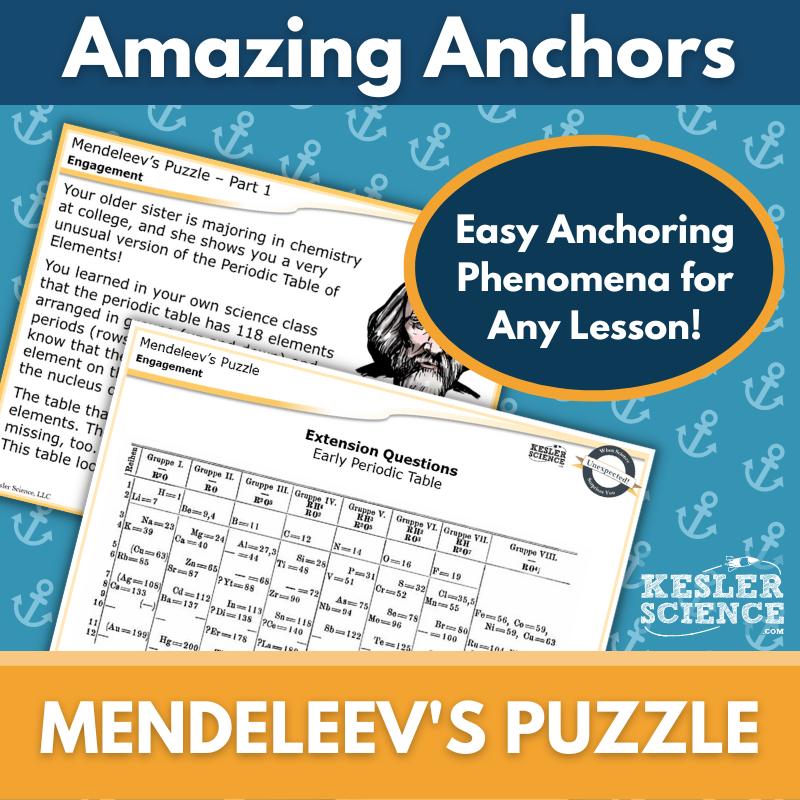Periodic Table and Reactivity Activities for Middle School Science
The Kesler Science Periodic Table and Reactivity resources offer a comprehensive, student-centered approach to teaching the periodic table, including engaging lesson plans, differentiated activities, and interactive stations. The resources below will give students a comprehensive understanding of the periodic table. All of the following materials are also included in the Kesler Science Membership.
The Kesler Science Periodic Table Complete 5E Lesson provides all the materials for an engaging, multi-day lesson with minimal prep and student-led learning. It allows students to explore how valence electrons affect reactivity and how elements are classified on the periodic table.
This lesson includes differentiated materials for all students and incorporates various learning formats, such as printable, digital, and editable resources. It is based on the 5E Model, which includes stages of Engagement, Exploration, Explanation, Elaboration, and Evaluation. Students engage through stations, readings, videos, and interactive activities that cater to multiple learning styles.
With features like editable PowerPoints, interactive notebooks, and Spanish translations, this lesson is flexible and ideal for both in-person and virtual learning environments, helping students master key concepts of the periodic table and chemical reactivity.
The Kesler Science Periodic Table Complete 5E Lesson provides all the materials for an engaging, multi-day lesson with minimal prep and student-led learning. It allows students to explore how valence electrons affect reactivity and how elements are classified on the periodic table.
This lesson includes differentiated materials for all students and incorporates various learning formats, such as printable, digital, and editable resources. It is based on the 5E Model, which includes stages of Engagement, Exploration, Explanation, Elaboration, and Evaluation. Students engage through stations, readings, videos, and interactive activities that cater to multiple learning styles.
With features like editable PowerPoints, interactive notebooks, and Spanish translations, this lesson is flexible and ideal for both in-person and virtual learning environments, helping students master key concepts of the periodic table and chemical reactivity.
The Kesler Science Periodic Table Station Lab provides a dynamic, student-led approach to learning about the periodic table. With nine modular stations, students engage in differentiated activities that foster a personalized learning experience. The teacher’s role is to facilitate rather than direct, allowing students to take control of their learning.
The stations include a variety of input and output activities, such as hands-on demonstrations, reading passages, videos, and tasks like organizing, illustrating, and writing about the periodic table. Additionally, a challenge station offers advanced students opportunities to extend their learning with crosswords and mini-projects.
This comprehensive station lab is fully modular, includes all necessary materials, and is designed for use in both physical classrooms and virtual learning environments, making it adaptable and versatile for all learners.
The Kesler Science Periodic Table Station Lab provides a dynamic, student-led approach to learning about the periodic table. With nine modular stations, students engage in differentiated activities that foster a personalized learning experience. The teacher’s role is to facilitate rather than direct, allowing students to take control of their learning.
The stations include a variety of input and output activities, such as hands-on demonstrations, reading passages, videos, and tasks like organizing, illustrating, and writing about the periodic table. Additionally, a challenge station offers advanced students opportunities to extend their learning with crosswords and mini-projects.
This comprehensive station lab is fully modular, includes all necessary materials, and is designed for use in both physical classrooms and virtual learning environments, making it adaptable and versatile for all learners.
The Kesler Science Periodic Table and Reactivity Student Choice Projects offer middle school students a variety of project options, allowing them to choose the format that best suits their learning style. With six project choices and a “design your own” option, students can explore the topic in a way that resonates with them, and a flexible rubric enables teachers to assess their work in multiple ways.
These projects are designed to be adaptable, with two versions of the project page to support diverse student needs. The modified version includes options for students needing additional support, while more advanced learners can tackle more complex project combinations. Teachers can easily adjust the rubric to fit their grading needs.
The projects use common classroom materials like paper, markers, and scissors, and many can be done digitally. This makes the Student Choice Projects both accessible and flexible, perfect for a wide range of learners and classroom settings.
The Kesler Science Periodic Table and Reactivity Student Choice Projects offer middle school students a variety of project options, allowing them to choose the format that best suits their learning style. With six project choices and a “design your own” option, students can explore the topic in a way that resonates with them, and a flexible rubric enables teachers to assess their work in multiple ways.
These projects are designed to be adaptable, with two versions of the project page to support diverse student needs. The modified version includes options for students needing additional support, while more advanced learners can tackle more complex project combinations. Teachers can easily adjust the rubric to fit their grading needs.
The projects use common classroom materials like paper, markers, and scissors, and many can be done digitally. This makes the Student Choice Projects both accessible and flexible, perfect for a wide range of learners and classroom settings.
The Kesler Science Chemistry Interactive Notebook Bundle provides an engaging way for students to explore chemistry concepts through interactive activities. Designed for both traditional classrooms and digital learning environments, this bundle includes print and digital versions, making it versatile for in-person, 1:1, or distance learning settings.
Topics covered include acids and bases, atoms, balancing chemical equations, chemical bonds, physical and chemical changes, the periodic table, properties of water, and more. The digital version features a unique PowerPoint interactive notebook that can be uploaded to platforms like Google Slides, MS Teams, or Schoology. It includes reflection pages, note-taking space, a teacher answer key, and a modified version for students needing accommodations.
The paper version offers blank templates for student interaction, pre-filled options for modified learners or absentees, and visual examples for guidance. This resource is ideal for fostering hands-on and digital engagement in middle school chemistry.
The Kesler Science Chemistry Interactive Notebook Bundle provides an engaging way for students to explore chemistry concepts through interactive activities. Designed for both traditional classrooms and digital learning environments, this bundle includes print and digital versions, making it versatile for in-person, 1:1, or distance learning settings.
Topics covered include acids and bases, atoms, balancing chemical equations, chemical bonds, physical and chemical changes, the periodic table, properties of water, and more. The digital version features a unique PowerPoint interactive notebook that can be uploaded to platforms like Google Slides, MS Teams, or Schoology. It includes reflection pages, note-taking space, a teacher answer key, and a modified version for students needing accommodations.
The paper version offers blank templates for student interaction, pre-filled options for modified learners or absentees, and visual examples for guidance. This resource is ideal for fostering hands-on and digital engagement in middle school chemistry.
The Kesler Science Periodic Table - Arrangement Inquiry Lab aligns with NGSS standards by guiding students through an exploration of how the periodic table is organized. Students will classify elements as metals, nonmetals, or metalloids, and discover how groups and periods can be used to predict element properties. Both digital and hands-on formats include comprehension questions, Claim-Evidence-Reasoning (C.E.R.) prompts, and opportunities for reflection.
This flexible lab comes in three differentiated versions—dependent, modified, and independent—to support a variety of learners. The dependent version provides guided instructions and questions, the modified version offers structured support with simplified tasks and sentence stems, and the independent version encourages advanced students to lead their own investigation.
Printable labs use materials like scissors, glue, and colored pencils, while the digital version requires no supplies and works within PowerPoint or Google Slides. Editable files, teacher resource pages, and answer keys make this lab easy to customize and implement in any middle school classroom.
The Kesler Science Periodic Table - Arrangement Inquiry Lab aligns with NGSS standards by guiding students through an exploration of how the periodic table is organized. Students will classify elements as metals, nonmetals, or metalloids, and discover how groups and periods can be used to predict element properties. Both digital and hands-on formats include comprehension questions, Claim-Evidence-Reasoning (C.E.R.) prompts, and opportunities for reflection.
This flexible lab comes in three differentiated versions—dependent, modified, and independent—to support a variety of learners. The dependent version provides guided instructions and questions, the modified version offers structured support with simplified tasks and sentence stems, and the independent version encourages advanced students to lead their own investigation.
Printable labs use materials like scissors, glue, and colored pencils, while the digital version requires no supplies and works within PowerPoint or Google Slides. Editable files, teacher resource pages, and answer keys make this lab easy to customize and implement in any middle school classroom.
The Kesler Science Periodic Table - Reactivity Inquiry Lab helps students explore how the number of protons determines an element’s identity and how valence electrons influence its reactivity. Students will use a periodic table and element model cards to make observations and analyze interactions between elements. This lab guides students in understanding atomic structure through both hands-on and digital formats.
Both versions include comprehension questions, Claim-Evidence-Reasoning (C.E.R.) prompts, and a reflection section. Each lab comes in three differentiated levels—dependent, modified, and independent—to support a wide range of learners. Editable resources allow teachers to tailor the experience for their classrooms, while built-in scaffolding and support make planning and instruction efficient.
For the hands-on version, students will use materials like colored pencils and element model cards, while the digital version requires no materials and is ideal for students working remotely. The flexible design of the lab ensures that all students can engage with the content in a meaningful and interactive way.
The Kesler Science Periodic Table - Reactivity Inquiry Lab helps students explore how the number of protons determines an element’s identity and how valence electrons influence its reactivity. Students will use a periodic table and element model cards to make observations and analyze interactions between elements. This lab guides students in understanding atomic structure through both hands-on and digital formats.
Both versions include comprehension questions, Claim-Evidence-Reasoning (C.E.R.) prompts, and a reflection section. Each lab comes in three differentiated levels—dependent, modified, and independent—to support a wide range of learners. Editable resources allow teachers to tailor the experience for their classrooms, while built-in scaffolding and support make planning and instruction efficient.
For the hands-on version, students will use materials like colored pencils and element model cards, while the digital version requires no materials and is ideal for students working remotely. The flexible design of the lab ensures that all students can engage with the content in a meaningful and interactive way.
The Kesler Science Periodic Table Sub Plans offer a comprehensive and engaging experience for students, perfect for classroom use, distance learning, or substitute teaching. Students begin with a warm-up, explore a reading passage, and analyze the periodic table to identify patterns and properties. They then create a detailed element book page, followed by extension activities for early finishers, such as crafting a text message conversation or matching elements to their properties. The lesson concludes with an assessment or exit ticket.
This resource includes everything needed for seamless implementation: detailed substitute instructions, answer keys, editable documents, and behavior checkpoints. Digital learning options include a student PDF for annotation and a Google Form answer sheet, making it ideal for remote or hybrid classrooms.
Designed to eliminate downtime, this student-centered lesson is versatile and can be used for sub plans, ISS assignments, homework, or extra credit. With its thoughtful structure and engaging activities, the Periodic Table Lesson ensures an effective and enjoyable learning experience, even in your absence.
The Kesler Science Periodic Table Sub Plans offer a comprehensive and engaging experience for students, perfect for classroom use, distance learning, or substitute teaching. Students begin with a warm-up, explore a reading passage, and analyze the periodic table to identify patterns and properties. They then create a detailed element book page, followed by extension activities for early finishers, such as crafting a text message conversation or matching elements to their properties. The lesson concludes with an assessment or exit ticket.
This resource includes everything needed for seamless implementation: detailed substitute instructions, answer keys, editable documents, and behavior checkpoints. Digital learning options include a student PDF for annotation and a Google Form answer sheet, making it ideal for remote or hybrid classrooms.
Designed to eliminate downtime, this student-centered lesson is versatile and can be used for sub plans, ISS assignments, homework, or extra credit. With its thoughtful structure and engaging activities, the Periodic Table Lesson ensures an effective and enjoyable learning experience, even in your absence.
The Kesler Science Periodic Table Escape Room offers a fun and immersive way for students to demonstrate their knowledge of the periodic table, including concepts like valence electrons, periods, groups, families, and reactivity. Teachers have full control over which puzzles to use and their order, making it easy to adapt to different class lengths. The escape room can be run using simple materials like manila envelopes or a more authentic setup with locks and a storage box.
The resource also includes two options for online use: a single-student digital version in PowerPoint or Google Slides and a printable version for home use. These come with teacher directions, answer keys, and video challenges to enhance engagement. The escape room features eight unique puzzles, digital answer sheets, and reward templates for further motivation.
Ideal for both in-person and virtual classrooms, this activity also offers 50+ prize ideas and 30 unique signs for photos, making it a memorable experience for students. It’s fully editable to meet classroom needs and can be customized for remote learning platforms like Google Classroom.
The Kesler Science Periodic Table Escape Room offers a fun and immersive way for students to demonstrate their knowledge of the periodic table, including concepts like valence electrons, periods, groups, families, and reactivity. Teachers have full control over which puzzles to use and their order, making it easy to adapt to different class lengths. The escape room can be run using simple materials like manila envelopes or a more authentic setup with locks and a storage box.
The resource also includes two options for online use: a single-student digital version in PowerPoint or Google Slides and a printable version for home use. These come with teacher directions, answer keys, and video challenges to enhance engagement. The escape room features eight unique puzzles, digital answer sheets, and reward templates for further motivation.
Ideal for both in-person and virtual classrooms, this activity also offers 50+ prize ideas and 30 unique signs for photos, making it a memorable experience for students. It’s fully editable to meet classroom needs and can be customized for remote learning platforms like Google Classroom.
The Kesler Science Periodic Table Reading Comprehension activity helps middle school students understand the structure of the periodic table, including groups and periods, through a nonfiction article. Students answer comprehension questions, label a periodic table, and complete a mini-project, reinforcing the material with hands-on activities. The leveled reading passages are designed to boost reading comprehension and science literacy.
Appropriate for grades 6-8, the activity features two reading levels with Lexile scores of 1100-1300, and includes 5-7 questions for each article, as well as a mini-project. The content comes with a Cornell notes template and colorful, easy-to-print graphics. The resource is fully adaptable for virtual learning environments, with files compatible with Google Classroom, MS Teams, Schoology, and Canvas.
This resource is ideal for various classroom situations, including absences, sub plans, and extra credit assignments. Teachers can use the passage to enhance science literacy, initiate classroom discussions, and reinforce textual analysis skills, making it a versatile tool for building student knowledge of the periodic table.
The Kesler Science Periodic Table Reading Comprehension activity helps middle school students understand the structure of the periodic table, including groups and periods, through a nonfiction article. Students answer comprehension questions, label a periodic table, and complete a mini-project, reinforcing the material with hands-on activities. The leveled reading passages are designed to boost reading comprehension and science literacy.
Appropriate for grades 6-8, the activity features two reading levels with Lexile scores of 1100-1300, and includes 5-7 questions for each article, as well as a mini-project. The content comes with a Cornell notes template and colorful, easy-to-print graphics. The resource is fully adaptable for virtual learning environments, with files compatible with Google Classroom, MS Teams, Schoology, and Canvas.
This resource is ideal for various classroom situations, including absences, sub plans, and extra credit assignments. Teachers can use the passage to enhance science literacy, initiate classroom discussions, and reinforce textual analysis skills, making it a versatile tool for building student knowledge of the periodic table.
The Kesler Science Periodic Table Writing Prompt Activity offers an engaging way for middle school students to test their knowledge of the periodic table through a song-based writing prompt. Designed for minimal prep and maximum student interaction, it encourages science reasoning and exploration while enriching students' writing skills. The activity is aligned with TEKS and NGSS standards, making it suitable for various classroom settings, including virtual learning.
With multiple versions of the prompt, including full-sized and half-sheet handouts, the activity can be adapted to suit diverse learning needs. A PowerPoint version is also available, which can be easily converted into Google Slides, allowing for seamless integration into both in-person and remote learning environments.
The Periodic Table Writing Prompt Activity is versatile and can be used for a variety of purposes, including pre-test assessments, student choice projects, extra credit, and even TELPAS samples. Its creative approach ensures that students stay engaged while gaining a deeper understanding of the periodic table.
The Kesler Science Periodic Table Writing Prompt Activity offers an engaging way for middle school students to test their knowledge of the periodic table through a song-based writing prompt. Designed for minimal prep and maximum student interaction, it encourages science reasoning and exploration while enriching students' writing skills. The activity is aligned with TEKS and NGSS standards, making it suitable for various classroom settings, including virtual learning.
With multiple versions of the prompt, including full-sized and half-sheet handouts, the activity can be adapted to suit diverse learning needs. A PowerPoint version is also available, which can be easily converted into Google Slides, allowing for seamless integration into both in-person and remote learning environments.
The Periodic Table Writing Prompt Activity is versatile and can be used for a variety of purposes, including pre-test assessments, student choice projects, extra credit, and even TELPAS samples. Its creative approach ensures that students stay engaged while gaining a deeper understanding of the periodic table.
The Kesler Science Chemistry WIKI Tickets provide a flexible and engaging way to assess 6th-8th grade students’ understanding of key science topics. Aligned with NGSS and TEKS standards, these formative assessments are designed for both in-person and virtual learning environments. Each of the 14 topics includes multiple formats: a display version for projection, three printable handout sizes, and interactive digital files available as editable PowerPoint or Google Slides. A bonus table of contents ensures clear alignment with standards, and all topics include at least one ticket, with some offering more.
WIKI Tickets, standing for "What I Know Is," can serve as exit tickets, bellringers, or quick checks for understanding. Students can respond digitally or on paper, depending on the setting. Topics such as atomic structure, density, chemical reactions, and periodic table arrangement are covered, offering a comprehensive approach to middle school chemistry.
The Kesler Science WIKI Tickets are colorful, versatile, and designed to meet the demands of any learning scenario. Whether in a classroom or remote setting, these assessments provide a fun and meaningful way to gauge student progress while keeping them engaged.
The Kesler Science Chemistry WIKI Tickets provide a flexible and engaging way to assess 6th-8th grade students’ understanding of key science topics. Aligned with NGSS and TEKS standards, these formative assessments are designed for both in-person and virtual learning environments. Each of the 14 topics includes multiple formats: a display version for projection, three printable handout sizes, and interactive digital files available as editable PowerPoint or Google Slides. A bonus table of contents ensures clear alignment with standards, and all topics include at least one ticket, with some offering more.
WIKI Tickets, standing for "What I Know Is," can serve as exit tickets, bellringers, or quick checks for understanding. Students can respond digitally or on paper, depending on the setting. Topics such as atomic structure, density, chemical reactions, and periodic table arrangement are covered, offering a comprehensive approach to middle school chemistry.
The Kesler Science WIKI Tickets are colorful, versatile, and designed to meet the demands of any learning scenario. Whether in a classroom or remote setting, these assessments provide a fun and meaningful way to gauge student progress while keeping them engaged.
The Kesler Science Chemistry Lesson Extensions offer an engaging solution for keeping fast finishers motivated and learning. By incorporating activities that challenge critical thinking and creativity, these extensions are ideal for filling downtime during testing, curbing distractions, and wrapping up lessons. They provide rigorous yet enjoyable opportunities for students ready to delve deeper into NGSS and TEKS chemistry standards.
Each Lesson Extension includes four creative activities designed to enrich the learning experience. The Puzzler improves problem-solving skills through relevant puzzles, while the Maker Space integrates STEAM connections with hands-on projects. The Tech Connection allows students to demonstrate their learning through digital media, and the Word Master brings creative writing into the science classroom. Teachers are supported with clear directions, answer keys, and resources available in both projection and print-friendly formats.
This bundle covers essential topics such as the periodic table, chemical reactions, synthetic materials, and atomic structures. These versatile tools provide high-level supplementary materials to challenge independent learners and offer a meaningful way to conclude chemistry lessons with engagement and purpose.
The Kesler Science Chemistry Lesson Extensions offer an engaging solution for keeping fast finishers motivated and learning. By incorporating activities that challenge critical thinking and creativity, these extensions are ideal for filling downtime during testing, curbing distractions, and wrapping up lessons. They provide rigorous yet enjoyable opportunities for students ready to delve deeper into NGSS and TEKS chemistry standards.
Each Lesson Extension includes four creative activities designed to enrich the learning experience. The Puzzler improves problem-solving skills through relevant puzzles, while the Maker Space integrates STEAM connections with hands-on projects. The Tech Connection allows students to demonstrate their learning through digital media, and the Word Master brings creative writing into the science classroom. Teachers are supported with clear directions, answer keys, and resources available in both projection and print-friendly formats.
This bundle covers essential topics such as the periodic table, chemical reactions, synthetic materials, and atomic structures. These versatile tools provide high-level supplementary materials to challenge independent learners and offer a meaningful way to conclude chemistry lessons with engagement and purpose.
This Amazing Anchors Phenomenon Lesson introduces and reinforces the periodic table through a real-world lens. Students begin with a reading about the creation of the first periodic table, followed by comprehension and extension questions that spark curiosity and build background knowledge. A second, explanatory reading breaks down the structure and organization of the periodic table, helping students deepen their understanding through additional questions and activities.
Aligned to TEKS standards, this no-prep resource includes teacher directions with answer keys, full-page projection slides, editable PowerPoint files for digital learning, and both full- and half-sheet printable handouts for interactive notebooks. The lesson is available in differentiated formats, with a modified version that includes sentence starters and accessible language to support all learners.
Designed to bookend any main science lesson, Amazing Anchors Phenomenon Pages are ideal for the Engagement and Elaborate phases of the 5E Model. Whether used in-person or digitally, this resource provides a powerful way to connect students with core science concepts through meaningful, structured learning.
This Amazing Anchors Phenomenon Lesson introduces and reinforces the periodic table through a real-world lens. Students begin with a reading about the creation of the first periodic table, followed by comprehension and extension questions that spark curiosity and build background knowledge. A second, explanatory reading breaks down the structure and organization of the periodic table, helping students deepen their understanding through additional questions and activities.
Aligned to TEKS standards, this no-prep resource includes teacher directions with answer keys, full-page projection slides, editable PowerPoint files for digital learning, and both full- and half-sheet printable handouts for interactive notebooks. The lesson is available in differentiated formats, with a modified version that includes sentence starters and accessible language to support all learners.
Designed to bookend any main science lesson, Amazing Anchors Phenomenon Pages are ideal for the Engagement and Elaborate phases of the 5E Model. Whether used in-person or digitally, this resource provides a powerful way to connect students with core science concepts through meaningful, structured learning.
Year-Round Resources
These year-round activities will increase your students' understanding of many middle school science topics. All of these activities are also included in the Kesler Science Membership.
Visual Data & Graphing
You're not alone if your students struggle with understanding graphs, charts, and tables. It's a skill that takes an enormous amount of practice. This resource will help students build a strong foundation in analyzing data and creating their own data visualizations.
Bell Ringers and Warm-Ups
These middle school science bell ringers are an excellent way to engage your students as soon as they walk into your classroom. This comprehensive FULL YEAR resource includes everything you need to start off each science class with an interesting warm-up activity.
Review Board Games
Each game board has been carefully designed to keep students engaged. There are 10 different action spaces on each board and dozens of question cards. All of the actions are related to science concepts and keep the students motivated throughout the game.
Each game is ready to play. Simply print out the board and the cards and let the students enjoy reviewing nine different units.
Essential Questions
Below are the essential questions associated with the lessons and activities included in this unit. This topic is only one of more than 100 middle school science topics included in the Kesler Science Membership.
-
How do valence electrons determine an atom’s chemical properties, including reactivity?
-
How are elements classified on the periodic table?
Kesler Science Membership
Imagine never having to search for another middle school science lesson again. The membership gives you access to ALL of the Kesler Science products in one place (Yes, including everything above).
Say goodbye to long hours of lesson prep.

